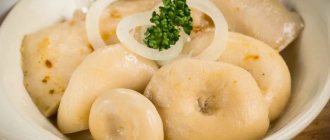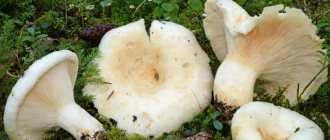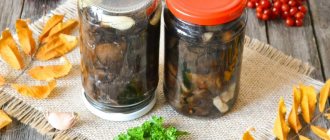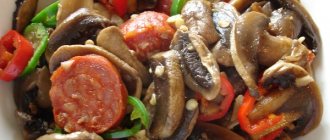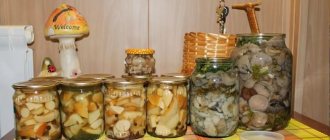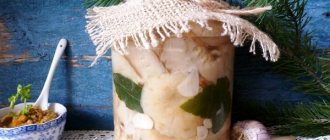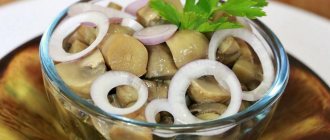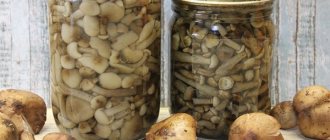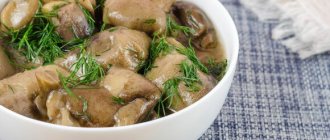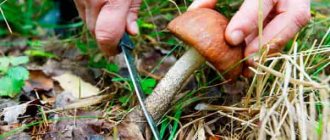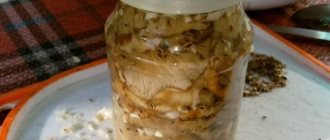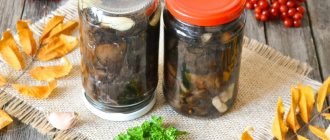Despite the fact that sanitary authorities warn us against preparing these mushrooms at home for the winter, salted pigs have their admirers in Russia. Previously, they were considered conditionally edible, and we habitually made mass preparations. Recently, cowsheds, as our hero is also called, have been classified as inedible. And all thanks to their ability to accumulate heavy metals and even poison in their caps.
If you are sure that you have collected mushrooms away from roads and industrial enterprises, and you know how to properly pickle mushrooms at home, use the suggested recipes. As a rule, in order to avoid troubles, mushrooms are pickled hot. Although a cold method is known, similar to the preparation of salted milk mushrooms , or saffron milk caps , which I told you about on the pages of the site. But still, it is better to use the old proven option with preliminary hot processing of mushrooms, so that the feast does not end with a collective visit to the hospital.
How to salt pork in a hot way
The method is quite troublesome, involving preliminary soaking and repeated boiling of cowsheds. This will make it possible to protect yourself and your family by salting barns at home in large quantities.
Take:
- Fresh pigs – 3 kg.
- Salt – 150 gr.
- Dill - umbrellas.
- Currant leaves – 10 pcs.
- Bay leaf – 4-5 pcs. (optional).
- Peppercorns – 10-15 pcs.
- Garlic cloves – 8-10 pcs.
Step by step recipe:
Sort through the mushrooms, mercilessly throw away the wormy, rotten overused ones. Rinse to remove dirt. Cut huge caps into several pieces. Fill with cold water for a day. During this time, try to change the water at least 4-5 times, adding fresh water.
Place the soaked barns in a saucepan and fill with clean water. Let it cook, adding a little salt to the water. Drain the first broth immediately after boiling. Pour water again, add salt, and boil for half an hour. Then do a third boil for another 30 minutes. You can stop at two boils, but then cook the pork for at least an hour.
Then drain in a colander and wait until all the liquid has drained.
At the bottom of the pickling dish, place some currant and bay leaves, if you decide to use them, peppercorns, and sliced garlic.
Next, place the pigs and sprinkle them with salt. Throw in some garlic and pepper. Then make the next layer of mushrooms, adding a little salt again.
Repeat the steps until you run out of cowsheds.
Press down the workpiece with pressure, placing it on a plate. Leave it for exactly one day. Then distribute the salted mushrooms among the jars and close the lids. Transfer to the cold - on a refrigerator shelf or in a cellar with a low temperature.
Is it possible or not?
Is it possible or not to eat pig mushrooms? Until the mid-twentieth century, the mushroom was considered quite edible, although not of the highest quality in its nutritional properties, until the first fatal case of pig poisoning was recorded in the 40s. Since then, in the West, this mushroom is clearly considered poisonous.
In our country, until 1981, Svinushka was considered conditionally an edible mushroom of the 4th and last category. But then in our country it was transferred to the category of poisonous, when substances that destroy red blood cells were discovered in the pig.
The biggest difficulty is that these substances are almost not destroyed during preliminary heat treatment, and their mechanism of action is cumulative, and they gradually concentrate in the human body until, one fine day, their quantity reaches a critical level, which may well result in severe poisoning and even death.
At the same time, Russian fans of pigs have been collecting and eating them for decades with the phrase “no one among us has died yet.”
We must remember that the degree of sensitivity of the human body to the toxins contained in pigs is strictly individual. And the degree of “critical mass” of these toxins in the body of each person is also individual. Therefore, someone can calmly eat pigs all their lives, while others will certainly receive severe poisoning as a reward for eating them.
In addition, pigs perfectly absorb various chemicals, radioisotopes, heavy metals, and other, not at all useful, substances from the polluted environment, accumulating all this in themselves, like a dormant bomb.
As a result, if you decide to use pigs for food, you must understand that you do so at your own peril and risk. This also applies to salted pigs, which, for a long time, have been stocked for the winter by seasoned and experienced mushroom pickers.
This article tells you how to properly and tasty pickle pig mushrooms for the winter, trying to make these mushrooms as safe as possible for health.
Hot salting of pigs - a simple recipe in jars
No seasonings, just mushrooms, salt and water.
Keep the simplest version of the workpiece. Required:
- Mushrooms – 3 kg.
- Salt – 150 gr.
- Water.
How to prepare:
- Prepare and soak mushrooms as described in the previous recipe, changing the water frequently.
- Place in a saucepan, pour in enough water and add salt.
- Bring to a boil, reduce heat. Cook at a gentle simmer for about an hour.
- Place the mushrooms in jars and fill with brine. Cover with a lid and place on the refrigerator shelf.
- Try the pork before serving. If you think that there is too much salt, soak for about an hour - the excess salt will go away.
Rules for home canning
How to properly sterilize jars:
- In the microwave - jars and lids should be washed with soda and mustard, and then wiped dry. Then boil the lids for 7 minutes, pour one and a half centimeters of water into the jars and rotate them for 5 minutes in the microwave at a power of 800 watts. They are eventually sterilized by hot steam from boiling water.
- In water - wash jars and lids thoroughly with laundry soap, and then boil in a large saucepan for 7 minutes. This is the simplest and most affordable way to sterilize pickling containers at home. Place the sterilized jars on a clean towel with the neck down.
- Using steam, wash the jars and lids thoroughly. Then boil water in a large container, put the lids directly into the water, and place the jars over the pan on a sieve or colander with their necks down. Boil for 25 minutes. The jars will be well sterilized when large drops of water appear inside them. The finished jars should be placed on a clean towel with their necks down.
- In the oven - jars and lids must be thoroughly washed and kept in the oven for 20 minutes at a temperature of 150. This method is not suitable only for lids - screws with rubber bands - they will have to be boiled separately.
How to properly preserve mushrooms
- The product must be placed in jars hot, immediately after preparation.
- The formation of voids inside the cans should not be allowed.
- The prepared lids need to be put on the jars, but do not screw them on yet.
- Then the jars must be disinfected again in a pan of water or oven for 15 minutes at a temperature of 120 degrees, then screw the lids tightly.
- While the jars are cooling, you need to turn them over onto the lids and wrap them tightly with some warm material. For example, an old blanket.
- Cooled jars should be stored in a cellar or other dark and cool place at a temperature of 0 to +8 degrees.
By following the correct technology for preliminary preparation of pigs for the salting process and following the correct recipes for pickling them, you will be able to stock these mushrooms for the winter as safely and effectively as possible.
Cold salting of pigs
Cold salting has some risk, but, nevertheless, many prefer it. Please note that only mushroom caps are used for pickling.
You will need:
- Pig hats - 1 kg.
- Salt – 2 large spoons.
- Dill - several sprigs.
- Currant leaves – 4-5 pcs.
- Garlic – 3-5 cloves.
How to salt:
- Clean, remove debris, remove dirt from the caps. Rinse the barns well. Divide large caps into 2-4 parts, leave small ones whole.
- First, soak the mushrooms thoroughly. Fill with cold water and leave for 1-2 days. Change the water frequently, adding a new portion of fresh liquid each time. While soaking, keep the bowl of pigs in a cool place to prevent them from souring.
- Place currant leaves and a sprig of dill in the pan. Fold the mushrooms in layers, interspersed with sliced garlic.
- Top with dill.
- Cover the workpiece with a plate and press it down with a heavier weight. The mushrooms will be ready after a month. Control the process by removing mold if it appears. Rinse the plate and bend.
Storage conditions
Pickling mushrooms correctly is one thing, but it is important to follow the rules for storing them so that they do not disappear over the winter.
If salted pigs are stored in a warm room where the temperature exceeds 6 degrees Celsius, then rest assured that they will quickly lose their taste and spoil. Also make sure that the room is not too cold; the mushrooms will freeze, which will negatively affect their taste and structure - they will break.
Pork salted in a wooden tub spoils the fastest. Sometimes the tree begins to mold; to get rid of the accumulation of fungus, you need to wipe the damaged areas with hot salt water. It is not recommended to wrap or cover the tubs; such measures will quickly lead to mold.
You need to monitor the amount of liquid; if it is not enough, then you just need to add cold boiled water.
The taste of pigs depends on the amount of salt in the solution. If there is a lot of it, then the mushrooms will be too salty, no matter how you wash them later. If there is not enough salt, they can ferment. There are many recipes for making salted pigs for the winter; we have presented the most popular and simple ones. Every housewife can make many adjustments to the cooking method, experiment with seasonings and ingredients and improve the recipe.
How to salt pigs for the winter - a quick recipe in jars
Very tasty mushrooms, since they are additionally fried. This allows you to fully reveal their taste.
We take:
- Fresh pigs – 4 kg.
- Garlic – 2-3 heads.
- Bay leaf – 12-15 pcs.
- Sweet peas – 10 pcs.
- Black peas – 10 pcs.
- Sunflower oil for frying.
- Salt – 8 large spoons.
Salting:
- Soak the pigs for 1-2 days, during which time be sure to change the water.
- Boil the mushrooms in salted water. Cooking time from the moment of boiling is 1.5 hours. Don't forget to skim off the foam.
- Discard the mushrooms, allowing excess liquid to drain.
- Transfer the cowtails to the frying pan and drizzle in a generous amount of oil to almost completely cover the slices.
- Add all seasonings. Chop the garlic and follow. Fry over moderate heat for about an hour. Stir the contents of the pan frequently, taste the mushrooms for salt as you go, and adjust the taste.
- Place the salted pigs in jars and close them with a nylon lid. When the preserves have cooled completely, place them in the refrigerator. After a day, you can try the snack.
Culinary secrets
In general, pigs are not very suitable for making soups or frying. But for salting - just right! Just choose small-sized mushrooms for this; if you use large specimens, their caps may spread. Moreover, you need to cook freshly picked pigs as quickly as possible, because they tend to spoil very quickly and even worms appear in them!
Immediately before pickling mushrooms, they need to be soaked for 24 hours in cool water, and you can add a little salt to it. The water should be changed periodically. The process of salting pigs in itself is not a troublesome task.
Features of the species and choice of edible fruits
So, you can only choose fat pigs for collection. Their flesh has a dense consistency and quickly darkens when cut. The fruit body tastes bitter and slightly sour. Outwardly, this specimen is very similar to saffron milk cap, but it secretes milky juice, while the sow does not have such juice. A distinctive feature of the pig is its brown cap with curved edges. The fetal leg is small, thick, with yellowish plates.
Mushrooms grow in small groups in coniferous and deciduous forests. Mushroom pickers advise choosing only young specimens when they are quite elastic inside. The young mushroom is small in size and has a slightly shaggy cap. Old fruits are most often loose inside.
When collecting this species, it is important to remember that thin pig spoils very quickly, so it should be heat treated as soon as possible. Even with a slight delay, the harvested crop may begin to rot.
Video
We invite you to get acquainted with another recipe for salting pigs in the following video:
He has been involved in gardening work, especially harvesting and preserving crops, since childhood. Excellent knowledge of the Russian language helps you share your secrets with readers. Twice mom, animal lover - there are two cats and a dog in the house. He enjoys experimenting in the garden - the field for them is located right behind the house. Therefore, I am ready to try new recipes for canning and pickling, as well as original dishes from my own harvest, and share them with you.
Answers to common questions
It often happens that the lid or tub becomes moldy. There is no need to throw them away, because this can be easily fixed. You should rinse the area with mold with salted and always hot water. If mold appears on the mushrooms themselves, then eating them is dangerous.
- among edible mushrooms there are poisonous false species;
- improper preparation for salting (undercooked pigs);
- violation of storage conditions (it is prohibited to store jars in a warm room).
If the mushroom picker’s basket is filled with pigs, it’s worth thinking about how you can preserve forest gifts for the winter. Salted and pickled mushrooms will be an excellent addition to the holiday table, provided they are prepared safely.
What mushrooms should you not pick?
Svinushki and any other mushrooms cannot be collected in the following areas:
- near industrial enterprises and large agricultural farms;
- near fields that are treated with chemical fertilizers and plant protection products;
- in the vicinity of landfills and landfills intended for storing household and industrial waste;
- in the right-of-way of railways and along the sides of highways;
- in gardens and parks located within the city.
In addition, edible mushrooms collected after a long drought, as well as too “mature” specimens (overgrown mushrooms), can be dangerous.
It must be remembered that if there is any deviation (unpleasant odor, unusual color of the cap or stem, unusual change in the flesh on the cut, etc.), the mushroom should be discarded immediately.
If you are not sure about the edibility of the mushrooms you find, it is better not to take them at all!
